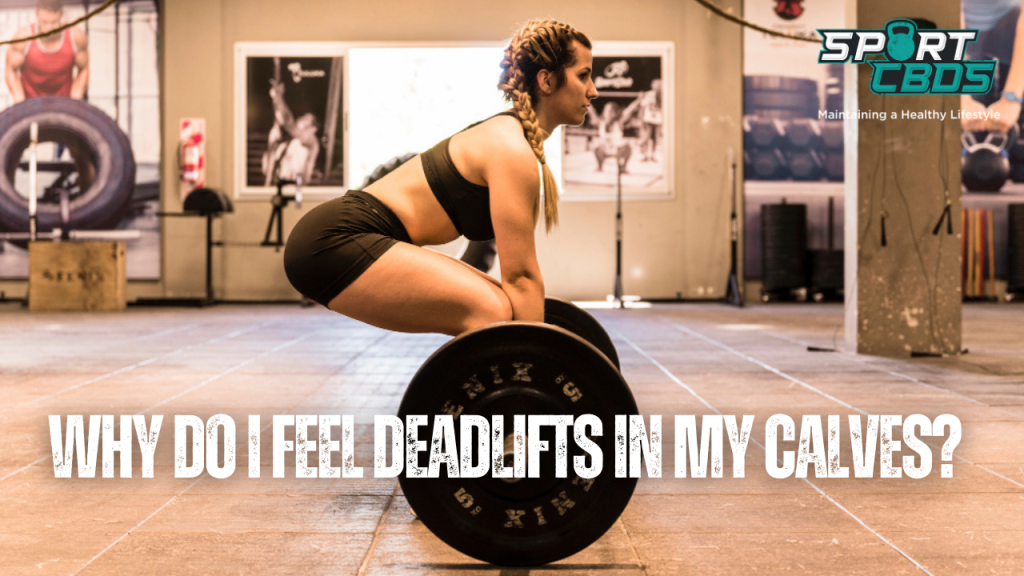
Why Do I Feel Deadlifts In My Calves? Everything You Need To Know
Calf pain during Romanian deadlifts (RDLs) can be a real setback when you’re striving to progress in your strength training journey. It can leave you frustrated and puzzled, wondering why you’re feeling the discomfort and what you can do about it.
In this comprehensive blog post, we’re going to delve deep into the potential causes of calf pain during RDLs and offer practical solutions to help you overcome this issue.
From sciatic nerve tension to muscle imbalances, we’ll break down each factor and provide actionable tips to alleviate your discomfort. So, let’s get started and make your RDL experience as pain-free as possible!
Why Do I Feel Deadlifts In My Calves?
If you’re experiencing calf pain during deadlifts, you might be wondering why this is the case? The answer lies in a few key factors that could contribute to this discomfort. One common cause is sciatic nerve tension, which can result from an imbalance in your posterior chain muscles. Another factor could be fascial restrictions in your posterior chain, limiting your range of motion and leading to discomfort in your calves. Muscle tension in the hamstrings, popliteus, and gastrocnemius muscles can also play a role in causing calf pain during deadlifts. There are also the other things to consider such as: Leaning and having the barbell too far forward, if deadlifts are new to you your body might take some time to settle into the exercise, if you have tight muscles, pushing through toes and ball of feet or rounding your back. Your choice of footwear can have a massive impact, as well lifting too heavy or having any muscle imbalances. Identifying the root cause of your calf pain and addressing it with targeted exercises, stretches, and self-massage techniques can help you perform deadlifts without pain and maximise the benefits of this powerful exercise.
A Quick Solution: Ankle Plantar flexion
Experiencing calf pain during RDLs can be frustrating, but there’s a quick solution you can try: ankle plantar flexion. By elevating your heels on a small weight plate or wedge, you’re allowing for greater ankle plantar flexion, where the ankle bends and the toes point downward.
This position reduces the stretch in your calves and may provide immediate relief from discomfort during RDLs. However, don’t forget to address the root cause of the problem for long-lasting results.
Sciatic Nerve Tension
One common reason for calf pain during RDLs is sciatic nerve tension. The sciatic nerve extends from the lower back down through the leg and can become irritated during specific exercises like RDLs. To determine if it’s sciatic nerve tension or hamstring tightness causing the pain, perform a straight leg raise test.
If the pain intensifies when your leg is raised and eases when lowered, it’s likely due to sciatic nerve tension. To alleviate this tension, try nerve glides. While lying on your back, extend one leg, flex the ankle, and gently move the foot up and down to floss the sciatic nerve. Aim for 10-15 repetitions per leg.
Fascia & the Posterior Chain
Fascia, the connective tissue that surrounds and binds muscles together, can also cause calf pain during RDLs if it becomes restricted in the posterior chain. This restriction can limit your range of motion and lead to discomfort. To address fascial restrictions, incorporate stretches and self-massage techniques into your routine.
Use a foam roller or lacrosse ball to massage your calves, hamstrings, and glutes, and try stretching exercises like seated forward bends and standing calf stretches. By consistently working on these techniques, you can improve your posterior chain’s flexibility and reduce calf pain during RDLs.
Referred Pain: The Hamstrings
Calf pain during RDLs can sometimes be attributed to referred pain from the hamstrings. Referred pain is a sensation of discomfort in a location other than the actual source of the problem. To tackle this issue, try including soft tissue massages and hamstring stretches in your routine.
For instance, sit on the floor with one leg extended and the other bent, with the foot touching the inner thigh of the extended leg. Lean forward gently, reaching for the toes of the extended leg, to feel a stretch in the hamstring.

The Popliteus
Another factor that can lead to calf pain during RDLs is the popliteus muscle, located at the back of the knee. This small but essential muscle helps stabilise the knee joint and control rotation.
To care for your popliteus, use self-treatment techniques such as massaging the back of the knee with a foam roller or a small massage ball. Gentle stretches targeting the popliteus can also help relieve tightness and discomfort.
Related: Why is Leg Day So Much More Exhausting Than Other Workout Days?
Tight Calves
Tight calf muscles are yet another common cause of calf pain during RDLs. To determine if your calves are tight, try a standing calf stretch. If you experience significant resistance or discomfort, your calves may be tight.
To address tight calves, include soft tissue massage, foam rolling, and stretching techniques in your routine. Use a foam roller or massage ball to work on your calves, applying gentle pressure to any tight areas or knots.
Incorporating stretching exercises like the standing calf stretch and the downward dog yoga pose can help elongate your calf muscles and relieve tightness. Regularly including these methods in your fitness routine can help prevent calf pain during RDLs and improve your overall performance.
Other Factors Contributing to Calf Pain During RDLs
Apart from the previously mentioned causes, there are various other factors that may lead to calf pain during RDLs:
Leaning and Barbell too Far Forward: Leaning excessively forward or keeping the barbell far from your body during RDLs can put additional stress on your calves. To maintain proper form, keep the barbell close to your body and ensure a neutral spine throughout the exercise.
New to the Exercise: If you’ve recently started performing RDLs, your body might be adjusting to the new movement pattern, which can temporarily cause discomfort in your calves. As your body adapts, gradually increase the weight and volume of your RDLs.
Tight Muscles in Other Areas: Tightness in other muscles, such as the glutes, hamstrings, or lower back, can also contribute to calf pain during RDLs. Include stretching and self-massage techniques targeting these muscle groups to alleviate tightness and discomfort.
Pushing Through Toes and Ball of Feet: Applying pressure through your toes and the ball of your feet during RDLs can put undue stress on your calves. Concentrate on driving through your heels and maintaining an even weight distribution across your feet.
Rounding Back: Rounding your back while performing RDLs can put excessive strain on your lower back and lead to calf pain. Keep a neutral spine and engage your core throughout the movement to avoid rounding.
Choice of Footwear: Wearing shoes that lack proper support or cushioning can contribute to calf pain during RDLs. Opt for footwear with adequate arch support and cushioning to help reduce discomfort.
Lifting too Heavy: Trying to lift weights beyond your current strength level can strain your muscles, including your calves. Incrementally increase the weight you lift to prevent overloading your muscles and causing injury.
Muscle Imbalances: Muscle imbalances can also cause calf pain during RDLs. Add exercises that target underdeveloped muscle groups to your routine to address these imbalances and prevent discomfort during RDLs. By focusing on these areas, you can help create a more balanced and pain-free workout experience.
Related: Why Do Squats Give Me A Headache?
Frequently Asked Questions
Do deadlifts work your calves?
Yes, deadlifts do engage your calf muscles, although they are not the primary target. The main muscles worked during deadlifts are the glutes, hamstrings, and lower back. However, your calves help stabilize your body and provide support during the lift.
Are you supposed to feel deadlifts in your legs?
Absolutely. Deadlifts are a compound exercise that primarily targets the muscles in your legs, including the hamstrings, glutes, and quadriceps. You should feel these muscles working during the lift. However, if you’re experiencing pain or discomfort in your calves or other leg muscles, it’s essential to assess your form and address any underlying issues.
Do deadlifts give you big calves?
Deadlifts can contribute to overall calf development, but they are not the most effective exercise for targeting the calf muscles specifically. For more significant calf growth, consider incorporating calf raises, seated calf raises, and other targeted calf exercises into your routine.
Why don’t I feel it in my legs when I deadlift?
If you’re not feeling the deadlift in your legs, it could be due to improper form or muscle imbalances. Ensure you’re maintaining a neutral spine, engaging your core, and driving through your heels during the lift. If you’re still not feeling it in your legs, consider working with a personal trainer or coach to assess and correct your form.
What muscles should you feel in deadlift?
During a deadlift, you should feel several muscles working, including the glutes, hamstrings, quadriceps, lower back, lats, and core. While the calves and other stabilizing muscles also play a role, they are not the primary targets of the deadlift.
What is the red flag of deadlifts?
A red flag during deadlifts is experiencing pain, discomfort, or excessive strain in any part of your body, particularly the lower back or legs. If you encounter any of these issues, it’s crucial to stop the exercise and assess your form. Consider working with a personal trainer or coach to identify and address any underlying problems or technique issues.
Final Thoughts…
Calf pain during Romanian deadlifts can be frustrating and challenging to manage. However, by understanding the potential causes and taking the necessary steps to address them, you can continue to enjoy the benefits of this powerful compound exercise.
Remember that a quick solution like ankle plantar flexion may provide immediate relief, but it’s essential to address the underlying issues in the long run. Evaluate your form, incorporate stretching and self-massage techniques, and consider your footwear and lifting habits to alleviate calf pain and improve your overall performance.
If you’re still experiencing discomfort or pain after trying these strategies, consider seeking guidance from a fitness professional or healthcare provider. They can help you identify any additional issues and develop a personalised plan to address your specific needs. With time, dedication, and the right approach, you can overcome calf pain during deadlifts and continue to progress in your fitness journey.
Do you feel deadlifts more in your calf muscles and have these tips helped? Let me know in the comment section below.
If you enjoy sports and use CBD to help with your recovery in between gruelling workouts, then you are in the right place. Here at Sport CBDs, we train hard and recover the best way possible.
We have regular workouts (check out the YouTube channel), CBD news and CBD products to help you gain that edge!
If you wanted to check out the reputable CBD we have on offer here at the site, then please head to the Sport CBDs Store (CLICK HERE). We also do fitness clothing and yoga accessories too.
Until next time, all the best…
Lee
Founder – Sport CBDs
Main Image Attribution – Image by Freepik


